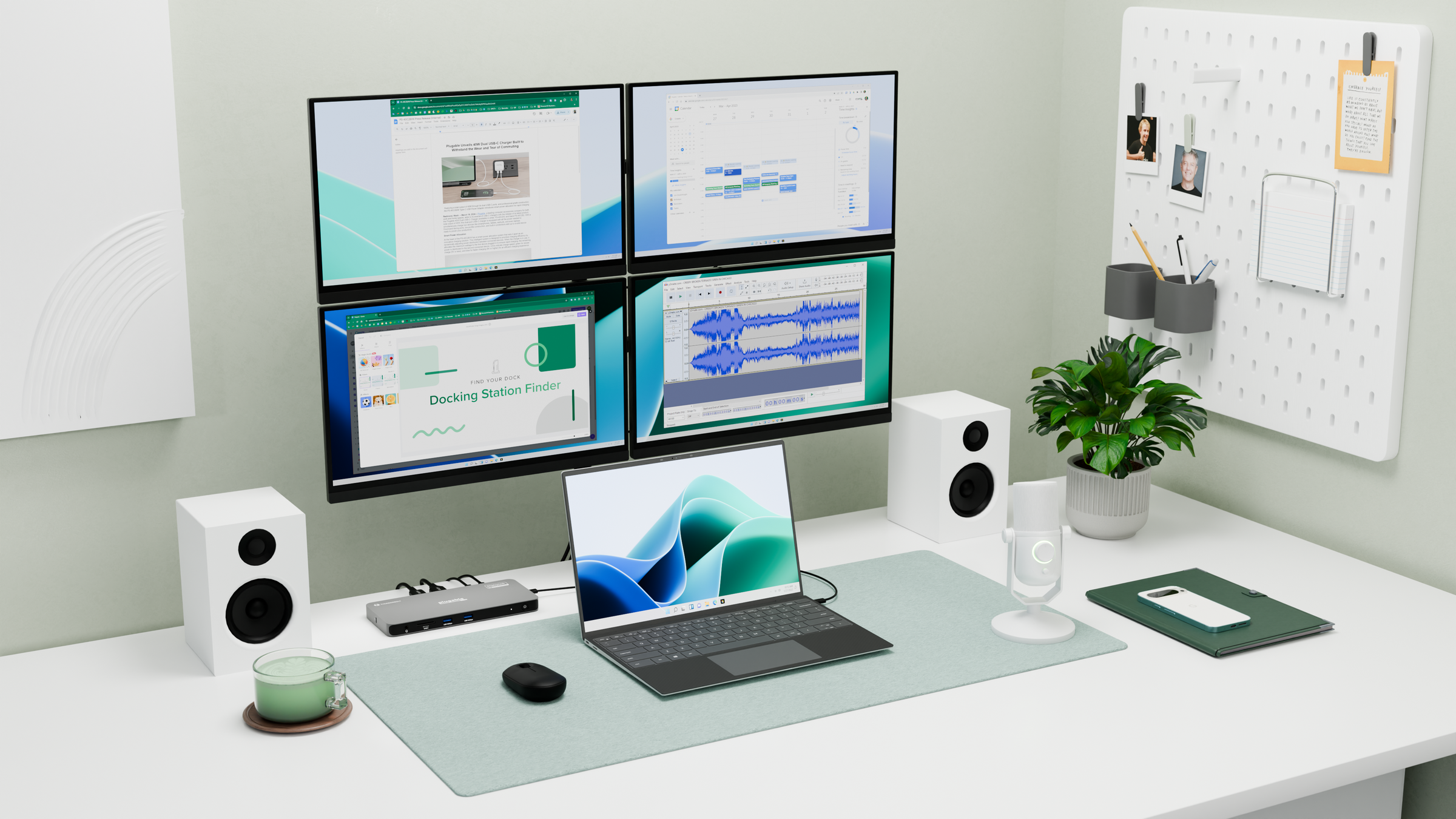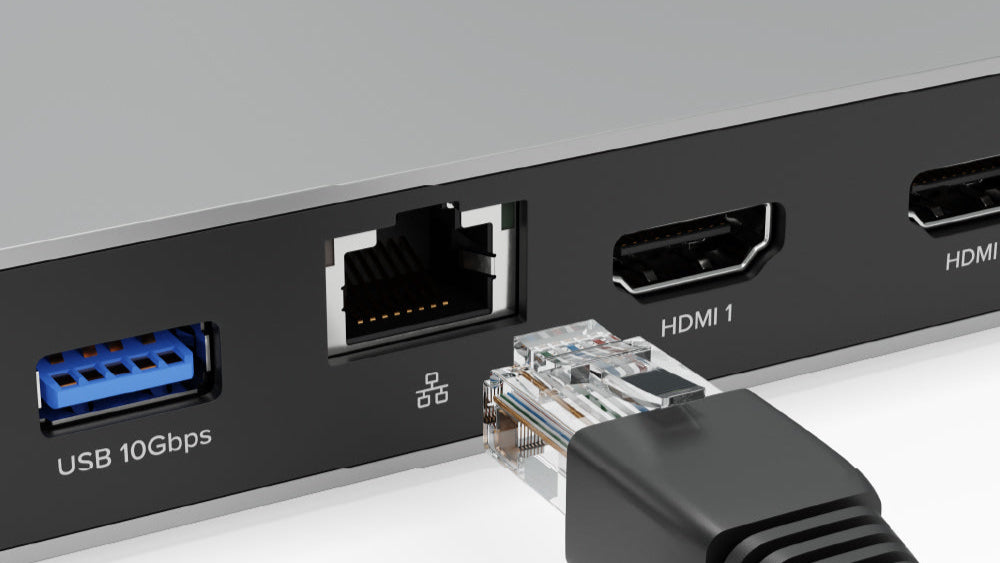The IT Buyer’s Guide to Docking Stations: 2025 Edition
Plugable Marketing | April 22, 2025

If you’re an IT buyer looking to outfit your enterprise setup with USB docking stations, you’ve probably noticed that they come in a dizzying array of options. Some support dual displays, while others can handle up to four. Some charge your laptop, while others don’t. And then there’s the whole compatibility issue of knowing whether your laptop supports the advertised features of the docking station.
So, how do you pick the right docking station for your setup? This docking station buyer’s guide will break down the key features you should consider before making a decision.
Host Connection: USB-A, USB-C, or Thunderbolt?
The first thing to check is how your docking station connects to your computer. This determines what features your dock can support.
USB-A Docks: A Legacy Connection
- Typically used with older laptops, but compatible with any USB 3.0 port
- Requires DisplayLink or similar technology for multiple displays
- Does not support laptop charging
USB-C Docks: The Modern Standard
- USB 3.1, USB 3.2, USB 3.2 Gen 2x2, and USB4
- Supports higher speeds (10Gbps to 40Gbps) and multiple displays
- Can offer Power Delivery (PD) charging
- Some docks use Alt Mode for native video support, but can still use DisplayLink for non-Alt Mode displays
Thunderbolt Docks: The Premium Option
- Supports up to 40Gbps speeds (Thunderbolt 3 and 4), or up to 80Gbps (Thunderbolt 5)
- Handles multiple high-resolution displays natively
- Offers faster data transfer rates
- Can offer downstream Thunderbolt ports to connect Thunderbolt peripherals
If your laptop supports Thunderbolt, it’s generally best to go with a Thunderbolt docking station for the highest performance. If universal compatibility across all your hosts is important, then a USB 3.0 docking station may be the best option.
Display Support: How Many Screens Do You Need?

One of the biggest reasons to buy a docking station is to expand your screen setup. Here’s what to look for:
Dual Displays
- Supported by most docking stations
- Great for productivity setups
Triple Displays
- Native support for triple displays often requires host to support Thunderbolt 4
- Many docks use DisplayLink technology for 1-2 of the monitors
- Increases productivity with an extra display compared to dual display docks
Quad Displays
- Native support for quad displays often requires host to support Thunderbolt 4
- Often uses DisplayLink technology for USB-A or USB-C setups
- Best for advanced multitasking and workstation setups
DisplayLink vs. Native Display Support
Some docks use DisplayLink, a technology that sends video over USB rather than relying on your laptop’s built-in graphics. Others support native video output (Alt Mode or Thunderbolt), which directly taps into your laptop’s GPU.
- DisplayLink Advantages: Works with more laptops, even those with USB-A ports
- Native Display Advantages: Offers lower latency and better performance, especially for gaming or video editing
It is worth noting that DisplayLink is great for general productivity tasks, but is not recommended for graphically intensive tasks like video rendering, gaming, etc. Consider your company’s workflow when determining whether DisplayLink is right for you.
Host Charging: Does the Dock Power Your Laptop?

Some docking stations provide Power Delivery (PD), which means they can charge your laptop while connected.
- No Charging: You’ll need to use your laptop’s power adapter separately
- 60W Charging: Suitable for most ultrabooks
- 85W-100W Charging: Needed for power-hungry laptops like the MacBook Pro 16” or gaming laptops
- Note that high-performance workstations with high power requirements may only charge over USB-C when the laptop is powered off
- 140W-240W EPR Charging: Suitable for charging nearly all devices that accept USB-C charging. Ports that accept these high wattages are often found on laptops with discrete GPU’s such as workstations and gaming laptops.
- Note that high-performance workstations with high power requirements may only charge over USB-C when the laptop is powered off
Make sure your dock’s power output matches your laptop’s requirements to avoid slow charging or power limitations.
USB Speeds: How Fast Are the Ports?
USB ports come in different speeds, and this can impact data transfer performance.
- USB 2.0 (480Mbps): Best for keyboards, mice, and printers
- USB 3.0 / 3.1 Gen 1 (5Gbps): Good for external drives and peripherals
- USB 3.2 (10Gbps): Ideal for fast SSDs and high-speed devices
- USB4 / Thunderbolt (40Gbps): Found on Thunderbolt docks, offering the highest speeds. Can often support Thunderbolt drives.
If you transfer large files frequently, opt for a dock with USB 10Gbps or higher ports.
Ethernet Speeds: Faster Internet, Fewer Drops

While Wi-Fi is convenient, a wired Ethernet connection offers faster speeds and lower latency. Docking stations come with different Ethernet options:
- Gigabit Ethernet (1Gbps): Standard for most docks
- 2.5Gb Ethernet: Faster speeds for high-bandwidth users
If you frequently transfer large files or work from a remote server, 2.5Gb is worth considering.
Other Ports: Which Extra Ports Do You Need?
Beyond the core features like display support and USB connectivity, docking stations can also come with a variety of additional ports that enhance convenience and functionality.
- For creatives and photographers, an SD or microSD card reader can be a game-changer, making it easy to transfer photos and videos without needing a separate adapter.
- 3.5mm audio jacks are another useful addition, allowing you to connect wired headphones, speakers, or microphones directly to the dock—especially handy for devices that lack a built-in headphone jack.
- Some docks also feature lock slots, which provide extra security by allowing you to physically tether the dock to a desk or workspace, reducing the risk of theft.
While these ports aren't found on every docking station, they can make a big difference in usability depending on your workflow. When choosing a dock, it's worth considering whether these extra features could streamline your setup.
Selecting the right docking station starts with understanding both your host laptop’s capabilities and the features of the dock you plan to connect. Ensuring compatibility with connection type, multiple monitor support, power delivery, and peripheral needs is essential for a seamless deployment, especially in IT environments managing multiple workstations. The right dock can simplify setup, reduce downtime, and enhance overall productivity by providing a reliable and efficient workflow for users. By carefully evaluating these factors upfront, IT teams can create a well-integrated docking solution that minimizes technical issues, maximizes performance, and supports a more productive and connected workplace.
Need help finding the perfect dock? Check out Plugable’s full lineup of USB-C, Thunderbolt, and DisplayLink docks here.
Don’t Miss Out. Be the first to know about new products, exclusive deals, and must-read insights—before everyone else.
View Other Articles in Category
Business, business-highlight, Docking Stations, Purchase Guide
Related Articles


Loading Comments